Affiliate disclosure: This post may contain affiliate links. Please see our Privacy Policy.
Ramps or wild leeks are usually just that…wild. They’re foraged in the early spring, by people who happen to know a “secret” patch, usually somewhere on public land. More often than not, your “secret spot” is the secret spot of a dozen other people, and even if each of you tries to harvest sustainably, those little ramps don’t stand a chance.
Wild populations are in decline, so much so that they’re now listed as threatened in many states. The good news is, they’re actually pretty easy to grow at home.
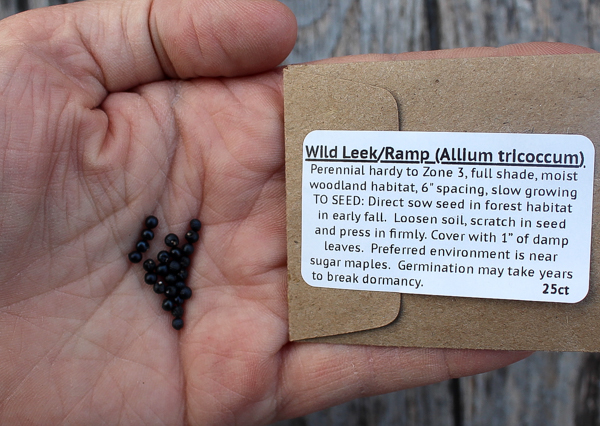
How to Grow Ramps (Wild Leeks)
To grow ramps, you need to know a few things about their life cycle. Ramps (Allium tricoccum) are a spring ephemeral, popping up in the woods before the trees above break bud. They do all their growing in just a few short weeks of the year, which means it can take around 7 years for them to reach maturity.
After 7 years of root growth, they begin to divide by and form new plants. They also send up seed stalks, sprouting in June after the leaves have soaked up plenty of sunlight. Each seedhead might stand for months before dropping seed, and the seed can take more than a year to germinate.
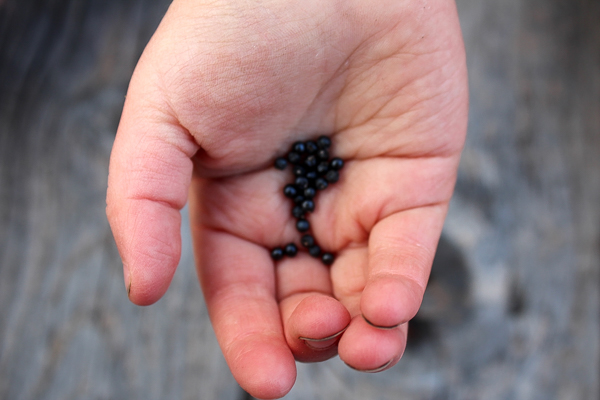
Once the seeds fall, they need a cold stratification period before they’ll break dormancy and germinate. For that reason, they’re often sown in the fall, but there’s no reason not to plant them anytime after June. That’s how the plants do it.
Ramps need shade to grow, or they’ll be outcompeted by grasses. They also need continuously moist, but not swampy soils. It’s best to plant them where maple, beech and hemlock grow as those trees require similar soils and provide good shade cover.
The book Farming the Woods, which provides detailed instructions for growing leeks and other wild forest edibles, says that they require at least 30% shade cover to survive, but they do better and grow larger leaves in denser shade cover.
The author’s instructions say, “to prepare a planting bed, remove debris and unwanted weeds and tree sprouts. Loosen the soil and incorporate organic matter such as compost and shredded leaves. Sow seeds on top, and gently press them into the soil. Cover with 2 to 4 inches of leaves.”
He also notes that moisture is critical, and though the soil should be well-drained and not swampy, it also should be continuously moist. The leaf mulch really helps with this.
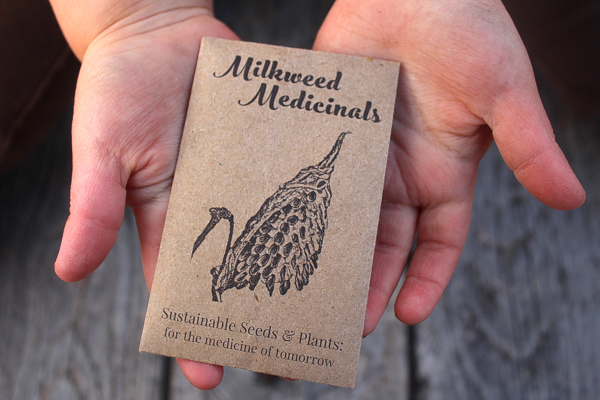
Where to Buy Ramp Seeds
We were ecstatic to find that our local food coop sells small packs of ramp seeds from a local seed company called Earthbeat Seeds (formerly Milkweed Medicinals). They have an impressive selection of wild forest plants and medicinals as well, so I’m happy to find them.
There are ramp seeds and ramp plants are available on Amazon, but be sure to read the reviews carefully.
Given that the seeds can take years to germinate, there’s not much stopping a company from selling you small black rocks. If you’re buying ramp seeds, make sure you’re buying them from someone you trust, or at least someone that’s got plenty of 5-star reviews.
You can also buy ramps online from D’artagnan and from a few shops on Etsy, where they’re sold as whole bulbs. That’s a good option if you want to taste them before you plant.
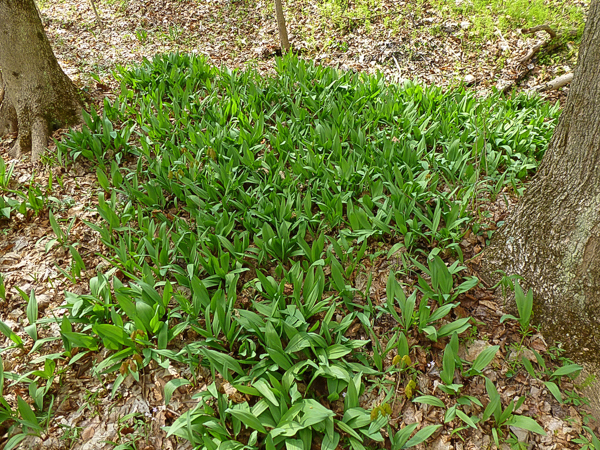
Growing Ramps from Transplants
Ramps can also be grown from transplants if you’re careful to take a large soil plug and not disturb the roots. Harvest about a cubic foot of soil from the edge of the patch, digging far from the nearest sprout you can see. Take the whole plug home and carefully plant it in a moist area under shade trees.
I’ve also heard stories of people that buy them from the farmer’s market and take them home to plant them. I don’t know how successful they are since the ramps are abused pretty heavily in the cleaning process.
Farmer’s market ramps usually don’t have many roots left, and they’ve been out of the soil for a long time. Still, I’ll give it a try this summer and let you know how it goes.

Harvesting Ramps Sustainably
Once you establish your own ramp patch, you’re responsible for harvesting sustainably. You’re not on public land anymore, and that little patch is your baby now. How many ramps can you harvest sustainably?
Initially, not much. Keep in mind that wild leeks need at least 7 years to grow to maturity. Before that, they’re not re-seeding and any you harvest will not have reproduced. Once they do begin seeding, studies show that you can harvest about 10% of the population in a good year without causing a decline. In a bad year, it’s more like 5%.
That’s a lot less than the 1/3 rule many foragers talk about. If you’re taking 1/3 of the plants in a wild area you’re causing a decline, and that assumes you’re the only one harvesting, which is likely, not true.
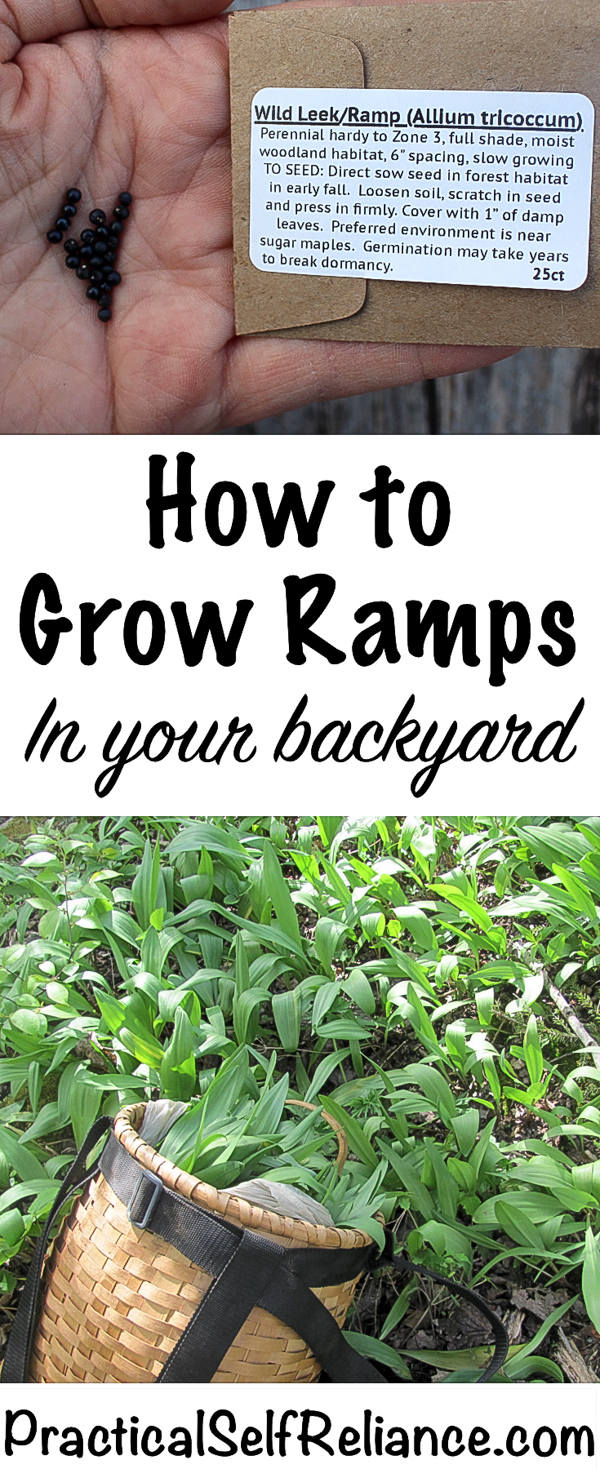




Some wild seeds can be hard to start in my experience. Ramp seeds need both warm moist and cool stratification to germinate, so it can take 2 years to see them if planted at the wrong time. Gardening is patience! I’m planning on planting both bulbs and seeds so I can get things going faster.
Last year I discovered a patch of wild ramps along our driveway – don’t know how I missed them in previous years, they’re mature enough to have set seed. Having learned first of their long maturity cycle I did not harvest. Inspired to start another patch, I ordered plants that, due to mail delays arrived in poor shape. Planted them anyway and also harvested and scattered seed from the mature patch in the fall. Now watching all those spots to see if anything took. Now that I know what they are, I’ve spotted them in abundance in the woods in our area, so will try to transplant some more.
That’s wonderful. I am so glad that you are choosing to propagate them and help them along.
I’ve been transplanting ramps every season for quite a few years now, and have established a couple dozen patches. In the early summer when the leaves are dying back but still easy to spot I dig bulbs and replant them in moist soil under hardwood. (If you see trilliums, you’ve found the proper habitat.)
In September I gather seeds and plant them when I go hiking. Not many of them seem to germinate, though.
That’s great that you are out there working to increase the ramp population.
When I dig ramps I bring them home and clean them, I cut the route ends off and take them to my woods and plant them. I dig up the soil and put a small amount of about 10 to 12 routes in and cover with about 4”” of soil and then leaves. The next year they will come up the same size as when I dug them fully mature. .
How do you plant a route?
I’ve transplanted quite a few small patches at my camp…in little bunches… They noe have spread out a lot… Really growing great now under the Beach trees around my spring area…When I planted them I used a all pole to make a hole… Then I just poked the roots into that….After that Ijust used my finger to poke all the dirt back down into the hole around them….It all was some years ago that I planted them…Since then I have seen the little clusters of tiny blue black seeds above them….Now I know they will be there forever…!! Put them in the scrambled eggs…!! I make the best soup with everything but the roots too…!!
I live in Wisconsin and found a beautiful patch in the wooded area of my property. I had to post a picture of them to find out what they were. I have trillium growing in this area too; so I thought it would be great to transplant and make my wooded area more colorful. Sad to hear that they die soon. I won’t be eating them. They are to delicate and pretty. I’ll enjoy them while they last
Thank you for the well written article. My brother told me about ramps and I have never heard of them before. I am a flower gardener and also cook a lot too. Apparently my cousin in WI has them growing wild on their land which is where my brother got them and said they were delicious!
I planted a handful of ramps from a market last year that had been in the fridge a bit too loony to eat. I have about as many plants popping up now, a year later. This is one small datapoint to answer your replanting question. They looked terrible last year after a week or so, so I had little hope, but they are beautiful now.
You can see ramps only in spring. The leaves die back. Go check now, they are up in southern Ohio.
I transplanted some bulbs in 2012 in oak tree shaded area.
I went to the spot in August 2019, but couldn’t see any ramps.
Do animal eat these?
Ramps are ephemeral and completely die back by the end of May or so, depending on where you are. If your ramps are growing (and I hope they are!) youwere probably just there at the wrong time.
Just take the leaves. Leave the bulbs to grow again. Just be sure you take the leaves sort of late in the season to give them time to energize the bulb.
In my experience, it’s almost impossible to germinate ramp seeds.
Fortunately, they are easy to grow from bulbs, which are available here https://wildwestvirginiaramps.com/order-ramp-bulbs/
I’ve generally used the rule to only harvest 1/3 of a plant, leaving most of each plant to grow. A small patch where I practiced this got bigger, so maybe this works.